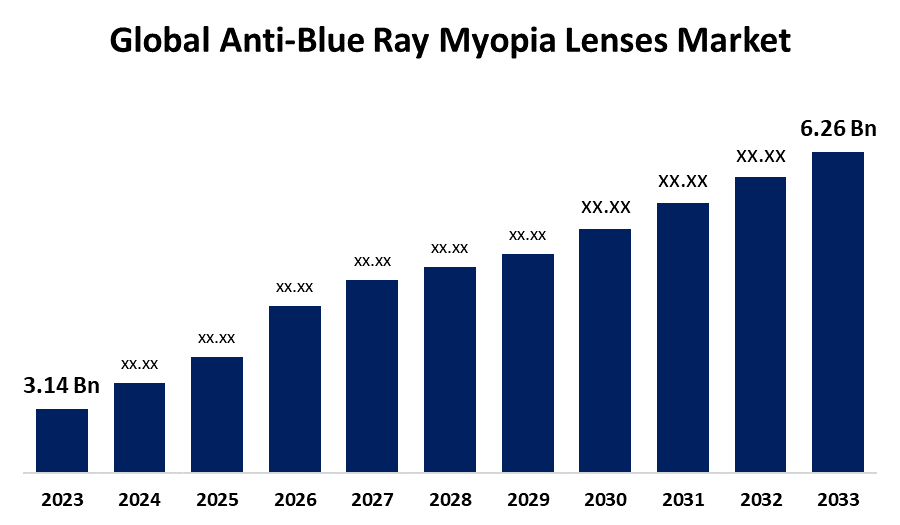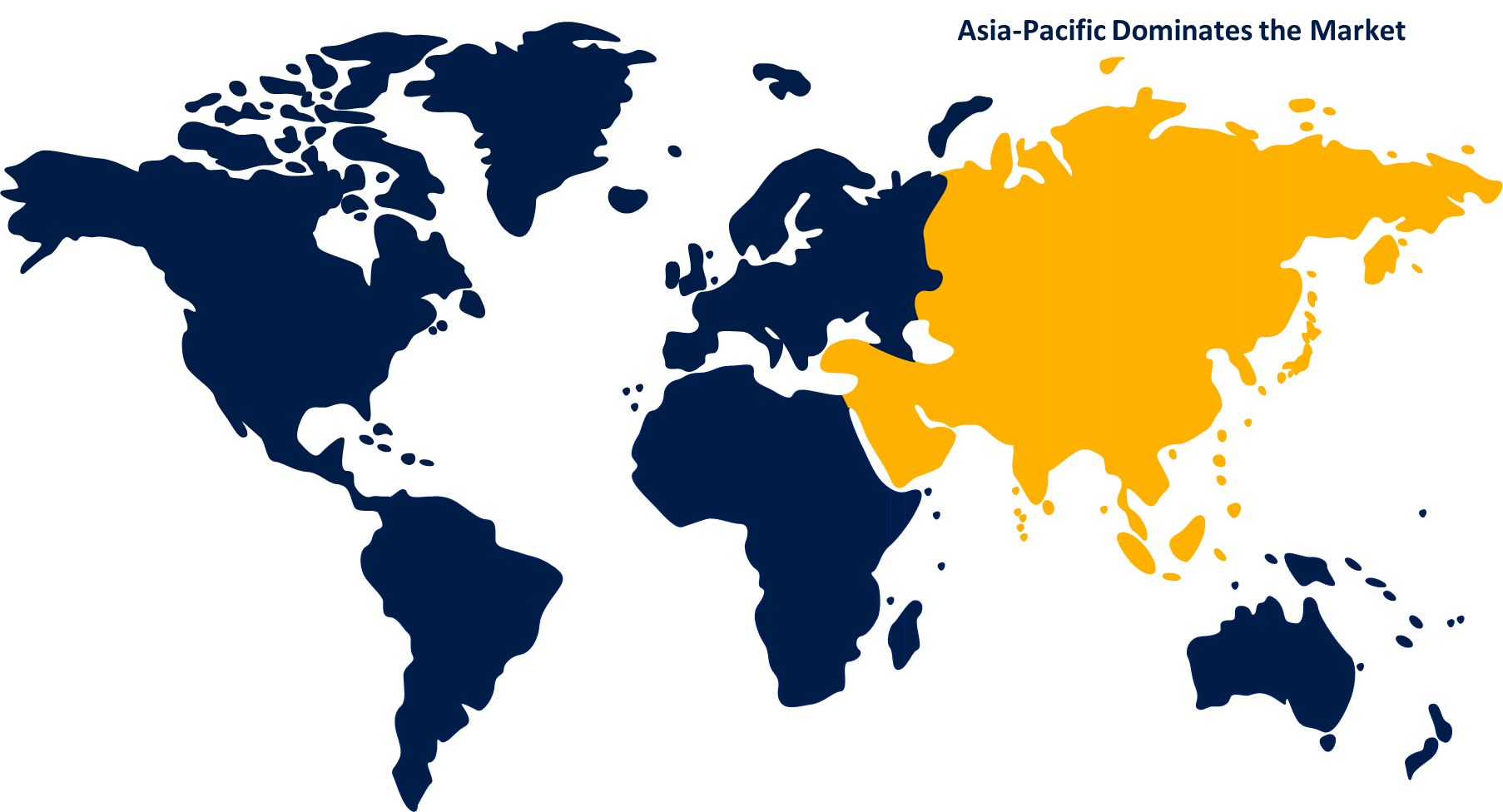Global Anti-Blue Ray Myopia Lenses Market Size, Share, and COVID-19 Impact Analysis, By Type (Single, Bifocal, Trifocal, and Others), By Distribution Channel (Retail Stores, Hospital and Clinics, and E-Commerce Platforms), and By Region (North America, Europe, Asia-Pacific, Latin America, Middle East, and Africa), Analysis and Forecast 2025 - 2035.
Industry: HealthcareGlobal Anti-Blue Ray Myopia Lenses Market Insights Forecasts to 2035
- The Global Anti-Blue Ray Myopia Lenses Market Size Was Estimated at USD 3.14 Billion in 2024
- The Market Size is Expected to Grow at a CAGR of around 6.47% from 2025 to 2035
- The Worldwide Anti-Blue Ray Myopia Lenses Market Size is Expected to Reach USD 6.26 Billion by 2035
- North America is expected to grow the fastest during the forecast period.

Get more details on this report -
The Global Anti-Blue Ray Myopia Lenses Market Size was worth around USD 3.14 Billion in 2024 and is Predicted to grow to around USD 6.26 Billion By 2035 with a compound annual growth rate (CAGR) of 6.47% from 2025 and 2035. Technology developments, rising demand from new economies, and the expanding use of online sales channels are the opportunities for anti-blue ray myopia lenses market.
Market Overview
The global industry devoted to the creation, manufacturing, and distribution of specialty optical lenses intended to reduce the negative effects of blue light exposure while treating myopia is known as the anti-blue ray myopia lenses market. High-energy visible (HEV) blue light from digital devices is filtered by these glasses, which lessen eye strain, guard against retinal damage, and promote visual comfort. The anti-blue ray myopia lenses market includes a range of lens types, including progressive, bifocal, and single vision lenses, and it caters to a wide range of age groups via clinical, retail, and online channels.
The market for anti-blue ray myopia lenses is expanding favorably due to improving living standards and fashion concerns. The market for anti-blue ray myopia lenses is anticipated to grow more quickly due to strategic collaborations among industry participants and the rise in eye diseases. The adoption of anti-blue ray myopia lenses is thought to be driven by their use as single, bifocal, trifocal, and other types of lenses. The growing popularity of online virtual try-ons for eyewear is expected to fuel the anti-blue ray myopia lenses market growth.
Report Coverage
This research report categorizes the anti-blue ray myopia lenses market based on various segments and regions, forecasts revenue growth, and analyzes trends in each submarket. The report analyses the key growth drivers, opportunities, and challenges influencing the anti-blue ray myopia lenses market. Recent market developments and competitive strategies such as expansion, type launch, development, partnership, merger, and acquisition have been included to draw the competitive landscape in the market. The report strategically identifies and profiles the key market players and analyses their core competencies in each sub-segment of the anti-blue ray myopia lenses market.
Global Anti-Blue Ray Myopia Lenses Market Report Coverage
| Report Coverage | Details |
|---|---|
| Base Year: | 2024 |
| Market Size in 2024: | USD 3.14 Billion |
| Forecast Period: | 2025-2035 |
| Forecast Period CAGR 2025-2035 : | CAGR of 6.47% |
| 2035 Value Projection: | USD 6.26 Billion |
| Historical Data for: | 2020-2023 |
| No. of Pages: | 190 |
| Tables, Charts & Figures: | 100 |
| Segments covered: | By Type, By Distribution Channel |
| Companies covered:: | Nikon, HOYA GROUP, Essilor, Shamir Optical Industry Ltd., Chemiglas Corp., Zeiss Group, Shanghai Conant Optics Co., Ltd., Mingyue Glasses Co., Ltd., Rodenstock GmbH, Seiko Optical Products, Inc., and Other Key Companies. |
| Pitfalls & Challenges: | COVID-19 Empact, Challenge, Future, Growth, & Analysis |
Get more details on this report -
Driving Factors
The growing incidence of myopia, or nearsightedness, and growing knowledge of the detrimental effects of blue light exposure on eye health are the main factors driving the market for anti-blue light myopia lenses. Growing awareness of the negative effects of blue light, increased demand for eye protection, and the expanding use of digital devices are the main factors propelling the market for anti-blue light myopia lenses. The creation of photochromic and variable focal length lenses, among other technological developments, has fueled anti-blue ray myopia lenses market expansion.
Restraining Factors
Anti-blue ray lenses are found to become yellow over time as a result of certain chemicals used in the lens production process, which limits the industry's ability to grow. These important concerns could have a detrimental effect on the anti-blue ray myopia lenses market.
Market Segmentation
The anti-blue ray myopia lenses market share is classified into type and distribution Channel.
- The single segment dominated the market in 2024 and is projected to grow at a substantial CAGR during the forecast period.
Based on the type, the anti-blue ray myopia lenses market is divided into single, bifocal, trifocal, and others. Among these, the single segment dominated the market in 2024 and is projected to grow at a substantial CAGR during the forecast period. The single segment due to is frequently used to treat nearsightedness and farsightedness, particularly in younger and middle-aged people which are exposed to digital screens more frequently.
- The retail stores segment accounted for the largest share in 2024 and is anticipated to grow at a significant CAGR during the forecast period.
Based on the distribution channel, the anti-blue ray myopia lenses market is divided into retail stores, hospital and clinics, and E-commerce platforms. Among these, the retail stores segment accounted for the largest share in 2024 and is anticipated to grow at a significant CAGR during the forecast period. The growth in the number of customers prefer retail establishments such as independent stores, wholesalers, and brand chains can be attributed to the retail stores segment.
Regional Segment Analysis of the Anti-Blue Ray Myopia Lenses Market
- North America (U.S., Canada, Mexico)
- Europe (Germany, France, U.K., Italy, Spain, Rest of Europe)
- Asia-Pacific (China, Japan, India, Rest of APAC)
- South America (Brazil and the Rest of South America)
- The Middle East and Africa (UAE, South Africa, Rest of MEA)
Asia Pacific is anticipated to hold the largest share of the anti-blue ray myopia lenses market over the predicted timeframe.

Get more details on this report -
Asia Pacific is anticipated to hold the largest share of the anti-blue ray myopia lenses market over the predicted timeframe. In the Asia-Pacific area, Myopia is a visual abnormality when the resting eye focuses the image of a faraway object at a point in front of the retina, resulting in a blurred image. It is also referred to as nearsightedness and shortsightedness. The growing prevalence of myopia, increased awareness of the negative effects of blue light on the eyes, and the expanding use of digital devices are the main factors driving the growth of the Asia Pacific market for anti-blue ray myopia lenses.
North America is expected to grow at a rapid CAGR in the anti-blue ray myopia lenses market during the forecast period. Increased screen time, increased awareness of the threats to eye health, and high disposable incomes are the main drivers of the growing demand. High levels of digital penetration, extensive insurance programs for eye care, and a growing network of specialty clinics are all advantages for North America. Teleoptometry services are now widely available, allowing both the consumer and pediatric markets to have anti-blue-ray lenses fitted remotely.
Competitive Analysis:
The report offers the appropriate analysis of the key organizations/companies involved within the anti-blue ray myopia lenses market, along with a comparative evaluation primarily based on their type of offering, business overviews, geographic presence, enterprise strategies, segment market share, and SWOT analysis. The report also provides an elaborative analysis focusing on the current news and developments of the companies, which includes type development, innovations, joint ventures, partnerships, mergers & acquisitions, strategic alliances, and others. This allows for the evaluation of the overall competition within the market.
List of Key Companies
- Nikon
- HOYA GROUP
- Essilor
- Shamir Optical Industry Ltd.
- Chemiglas Corp.
- Zeiss Group
- Shanghai Conant Optics Co., Ltd.
- Mingyue Glasses Co., Ltd.
- Rodenstock GmbH
- Seiko Optical Products, Inc.
- Others
Key Target Audience
- Market Players
- Investors
- End-users
- Government Authorities
- Consulting And Research Firm
- Venture capitalists
- Value-Added Resellers (VARs)
Market Segment
This study forecasts revenue at global, regional, and country levels from 2020 to 2035. Spherical Insights has segmented the anti-blue ray myopia lenses market based on the below-mentioned segments
Global Anti-Blue Ray Myopia Lenses Market, By Type
- Single
- Bifocal
- Trifocal
- Others
Global Anti-Blue Ray Myopia Lenses Market, By Distribution Channel
- Retail Stores
- Hospital and Clinics
- E-Commerce Platforms
Global Anti-Blue Ray Myopia Lenses Market, By Regional Analysis
- North America
- US
- Canada
- Mexico
- Europe
- Germany
- UK
- France
- Italy
- Spain
- Russia
- Rest of Europe
- Asia Pacific
- China
- Japan
- India
- South Korea
- Australia
- Rest of Asia Pacific
- South America
- Brazil
- Argentina
- Rest of South America
- Middle East & Africa
- UAE
- Saudi Arabia
- Qatar
- South Africa
- Rest of the Middle East & Africa
Frequently Asked Questions (FAQ)
-
1. What is the CAGR of the anti-blue ray myopia lenses market over the forecast period?The global anti-blue ray myopia lenses market is projected to expand at a CAGR of 6.47% during the forecast period.
-
2. What is the market size of the anti-blue ray myopia lenses market?The global anti-blue ray myopia lenses market size is expected to grow from USD 3.14 Billion in 2024 to USD 6.26 Billion by 2035, at a CAGR of 6.47% during the forecast period 2025-2035.
-
3. Which region holds the largest share of the anti-blue ray myopia lenses market?Asia Pacific is anticipated to hold the largest share of the anti-blue ray myopia lenses market over the predicted timeframe.
Need help to buy this report?